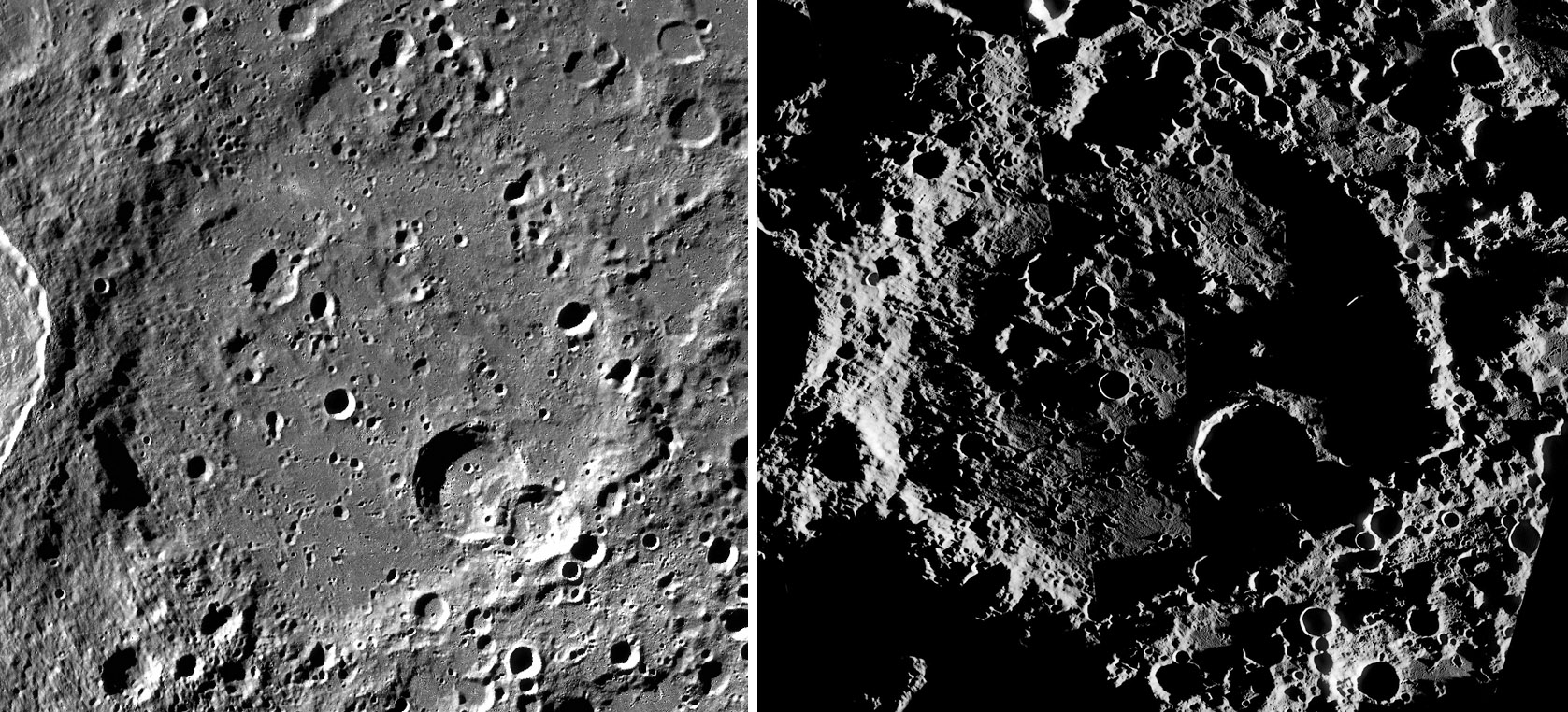Difference between revisions of "October 15, 2012"
| Line 6: | Line 6: | ||
<em>left LRO mage from [http://wms.lroc.asu.edu/lroc#damoon LROC WMS Image Browser] and right processed by [mailto:mauricejscollins@hotmail.com Maurice Collins]</em><br /> | <em>left LRO mage from [http://wms.lroc.asu.edu/lroc#damoon LROC WMS Image Browser] and right processed by [mailto:mauricejscollins@hotmail.com Maurice Collins]</em><br /> | ||
<br /> | <br /> | ||
| − | The standard LRO depiction of the poles uses high illumination images to provide views of craters with minimum shadowing. | + | The standard LRO depiction of the poles uses high illumination images to provide views of craters with minimum shadowing. |
| − | Maurice has found 45 images with considerable lower lighting conditions to compile the dramatic view of Bailly at right. Whether | + | Maurice has found 45 images with considerable lower lighting conditions to compile the dramatic view of Bailly at right. Whether |
| − | we should say the right view exaggerates or brings out the topography may be a matter of style but the two views reveal | + | we should say the right view exaggerates or brings out the topography may be a matter of style but the two views reveal complementary things. The shadows on the right emphasize that the bottom-right rim is rather straight, although it is not obvious that |
| − | + | any larger basin somehow influenced it. Debris from the Orientale impact is visible on the far left of the floor, and the right image | |
| − | any larger basin somehow influenced it. Debris from the Orientale impact is visible on the far left of the floor, and the right image | + | shows smaller Orientale-derived striations continue on the nearby smoother part of Bailly's floor. Maurice's mosaic reveals the |
| − | shows smaller Orientale-derived striations continue on the nearby smoother part of Bailly's floor. Maurice's mosaic reveals the | + | curved ridge on the left that Bill Hartmann and I in 1971 proposed was a segment of an inner ring, making Bailly a two-ring basin; |
| − | curved ridge on the left that Bill Hartmann and I in 1971 proposed was a segment of an inner ring, making Bailly a two-ring basin; | + | the opposite side of the ring is more mountainous and is also visible. Just beyond that ring on the upper right of Bailly's floor is a |
| − | the opposite side of the ring is more mountainous and is also visible. Just beyond that ring on the upper right of Bailly's floor is a | + | thin rille or fracture that is completely invisible in the other view. The Sun is shining perpendicular to the rille, thus it casts a shadow, |
| − | thin rille or fracture that is completely invisible in the other view. The Sun is shining perpendicular to the rille, thus it casts a shadow, | + | on the low illumination image, and the lighting is along the trend of the rille in the other view so the rille is gone there. Finally, the |
| − | on the low illumination image, and the lighting is along the trend of the rille in the other view so the rille is gone there. Finally, the | + | higher Sun view shows a large landslide inside [http://the-moon.wikispaces.com/file/detail/Rukl_71_satellites_SE.jpg Bailly B], the largest crater inside Bailly, caused by the impact on its rim of Bailly A. |
| − | higher Sun view shows a large landslide inside [http://the-moon.wikispaces.com/file/detail/Rukl_71_satellites_SE.jpg Bailly B], the largest crater inside Bailly, caused by the impact on its rim of Bailly A.<br /> | + | <br /> |
<br /> | <br /> | ||
[mailto:tychocrater@yahoo.com Chuck Wood]<br /> | [mailto:tychocrater@yahoo.com Chuck Wood]<br /> | ||
Revision as of 13:16, 14 March 2015
Parallel And Perpendicular Lighting

left LRO mage from LROC WMS Image Browser and right processed by Maurice Collins
The standard LRO depiction of the poles uses high illumination images to provide views of craters with minimum shadowing.
Maurice has found 45 images with considerable lower lighting conditions to compile the dramatic view of Bailly at right. Whether
we should say the right view exaggerates or brings out the topography may be a matter of style but the two views reveal complementary things. The shadows on the right emphasize that the bottom-right rim is rather straight, although it is not obvious that
any larger basin somehow influenced it. Debris from the Orientale impact is visible on the far left of the floor, and the right image
shows smaller Orientale-derived striations continue on the nearby smoother part of Bailly's floor. Maurice's mosaic reveals the
curved ridge on the left that Bill Hartmann and I in 1971 proposed was a segment of an inner ring, making Bailly a two-ring basin;
the opposite side of the ring is more mountainous and is also visible. Just beyond that ring on the upper right of Bailly's floor is a
thin rille or fracture that is completely invisible in the other view. The Sun is shining perpendicular to the rille, thus it casts a shadow,
on the low illumination image, and the lighting is along the trend of the rille in the other view so the rille is gone there. Finally, the
higher Sun view shows a large landslide inside Bailly B, the largest crater inside Bailly, caused by the impact on its rim of Bailly A.
Chuck Wood
Related Links
Rükl plate 71
Yesterday's LPOD: Tilted Sliver
Tomorrow's LPOD: Two Views of Ancient Heros
COMMENTS?
Register, Log in, and join in the comments.



